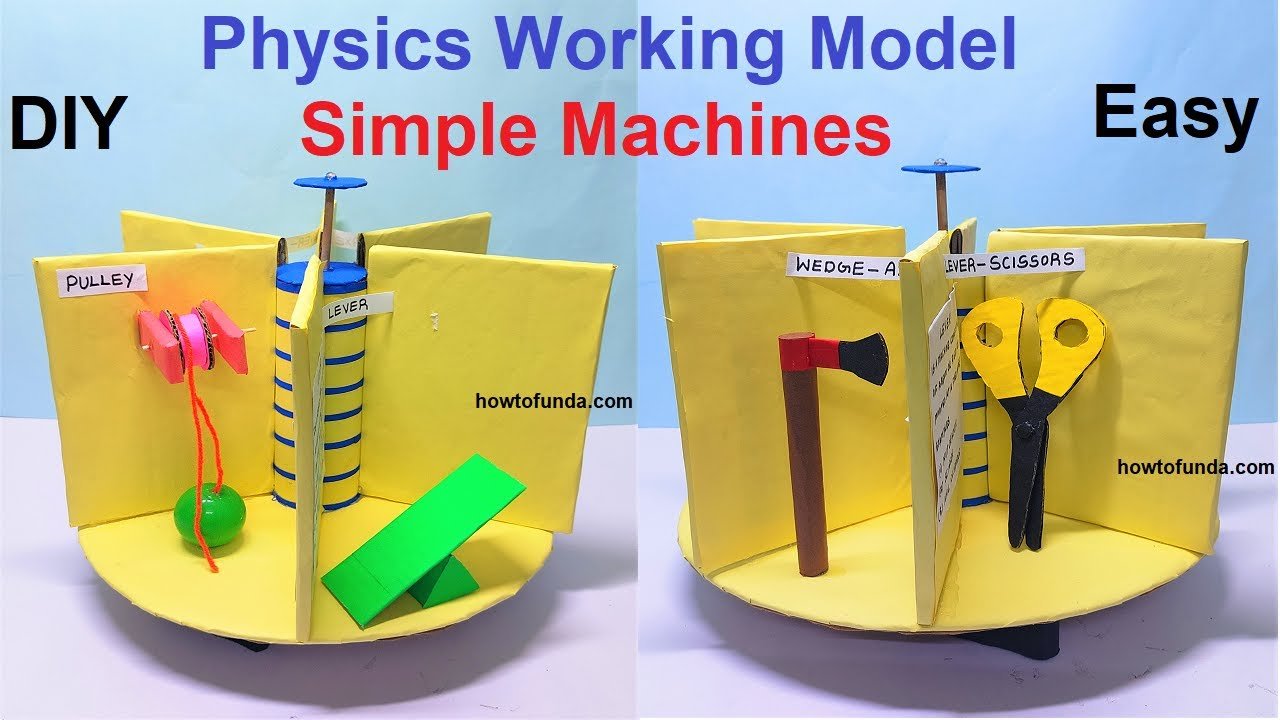Creating working models for physics projects can be an exciting and educational experience.

Here are 25 ideas for physics working models, each covering different principles and phenomena in physics:
Mechanics
- Simple Pendulum:
- Materials: String, weight, protractor.
- Description: Demonstrate simple harmonic motion and calculate the period of a pendulum.
- Lever and Fulcrum:
- Materials: Ruler, fulcrum (e.g., a block), weights.
- Description: Show how levers work and calculate mechanical advantage.
- Pulley System:
- Materials: Pulleys, string, weights.
- Description: Construct different types of pulley systems to demonstrate mechanical advantage.
- Inclined Plane:
- Materials: Board, protractor, weights.
- Description: Show how inclined planes reduce the effort needed to lift objects and calculate the mechanical advantage.
- Catapult:
- Materials: Wood, rubber bands, plastic spoon.
- Description: Build a simple catapult to demonstrate projectile motion and energy transfer.
Energy and Thermodynamics
- Wind Turbine:
- Materials: Cardboard, motor, blades.
- Description: Construct a model wind turbine to demonstrate the conversion of kinetic energy to electrical energy.
- Solar Oven:
- Materials: Cardboard box, aluminum foil, plastic wrap.
- Description: Build a solar oven to demonstrate the greenhouse effect and energy conversion.
- Hydraulic Lift:
- Materials: Syringes, tubing, water.
- Description: Create a simple hydraulic lift to demonstrate Pascal’s principle.
- Steam Engine:
- Materials: Tin can, candle, water, tubing.
- Description: Build a small steam engine to show the conversion of thermal energy to mechanical work.
- Thermoelectric Generator:
- Materials: Peltier module, heat source, fan.
- Description: Construct a model to demonstrate the Seebeck effect and generate electricity from heat.
Electricity and Magnetism
- Electromagnet:
- Materials: Iron nail, copper wire, battery.
- Description: Create an electromagnet and explore how electricity can produce a magnetic field.
- Simple Electric Motor:
- Materials: Battery, copper wire, magnets.
- Description: Build a simple electric motor to demonstrate the principles of electromagnetism.
- Series and Parallel Circuits:
- Materials: Batteries, wires, light bulbs.
- Description: Construct series and parallel circuits to explore how electrical current flows.
- Faraday’s Law Experiment:
- Materials: Coil of wire, magnet, galvanometer.
- Description: Demonstrate electromagnetic induction by moving a magnet through a coil of wire.
- Capacitor Demonstration:
- Materials: Aluminum foil, paper, multimeter.
- Description: Build a simple capacitor to show how capacitors store and release electrical energy.
Waves and Optics
- Wave Tank:
- Materials: Clear container, water, objects to create waves.
- Description: Create a wave tank to demonstrate wave properties like reflection, refraction, and diffraction.
- Optical Fiber Model:
- Materials: Clear plastic tubing, laser pointer.
- Description: Demonstrate total internal reflection using a laser pointer and clear plastic tubing.
- Lenses and Light:
- Materials: Lenses, light source, screen.
- Description: Explore how convex and concave lenses bend light and form images.
- Periscope:
- Materials: Mirrors, cardboard tubes.
- Description: Build a periscope to demonstrate the principles of reflection and light paths.
- Spectroscope:
- Materials: CD, cardboard tube, black paper.
- Description: Create a simple spectroscope to analyze light from different sources.
Modern Physics
- Particle Accelerator Model:
- Materials: Magnets, metal balls, track.
- Description: Demonstrate the basic principles of a particle accelerator using magnets and metal balls.
- Cloud Chamber:
- Materials: Dry ice, isopropyl alcohol, clear container.
- Description: Build a cloud chamber to visualize the paths of ionizing particles.
- Model of the Hydrogen Atom:
- Materials: Styrofoam balls, wire.
- Description: Create a model to show the structure of the hydrogen atom and electron orbitals.
- Quantum Levitation:
- Materials: Superconductor, magnets, liquid nitrogen.
- Description: Demonstrate quantum levitation with a superconductor and magnets.
- Nuclear Fission Model:
- Materials: Marbles, mousetraps.
- Description: Simulate a chain reaction using mousetraps and marbles to represent nuclear fission.
Each of these models offers a hands-on way to explore fundamental concepts in physics, from classical mechanics to modern physics.

